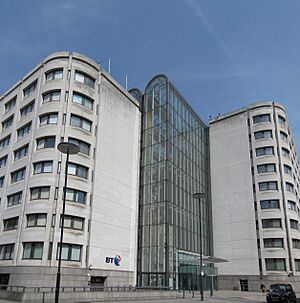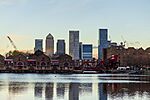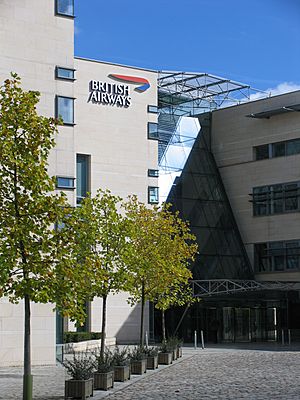Economy of London facts for kids
|
London is Europe's largest city economy and a major player in the global economy.
|
|
| Statistics | |
|---|---|
| Population | 8,866,180 (2022) |
| GDP | £617.915 billion (2023) |
|
GDP per capita
|
£69,077 (2023) |
|
Labour force
|
4,726,000 / 74.4% in employment (Jan–Mar 2024) |
|
Labour force by occupation
|
List
33.2% Professional
16.9% Associate professional 13.1% Managers, directors and senior officials 8.9% Administrative and secretarial 6.6% Elementary occupations 6.5% Caring, leisure and other service 6.0% Skilled trades 5.5% Sales and customer service 3.2% Process plant and machine operatives (Jan–Dec 2023) |
| Unemployment | 228,000 / 4.6% (Jan–Mar 2024) |
|
Average gross salary
|
£796.30 per week (2023) |
| External | |
| Exports | £190.0 billion (2021) |
|
Export goods
|
£37.8 billion (2021) |
| Imports | £138.5 billion (2021) |
|
Import goods
|
£62.6 billion (2021) |
The economy of London is mostly made up of service industries. These include financial services and other professional services like law and accounting. London is the capital city of the United Kingdom and a major financial hub for international business. It is also one of the most important cities for the global economy.
London is the most populated area in the UK. In 2011, its economy was ranked the fifth largest among cities worldwide. London creates about 22% of the UK's total economic output. In early 2013, there were 841,000 private businesses in London, more than in any other part of the UK. Many of these are small and medium-sized companies.
Contents
London's Economic Output
London's economy is very large. In 2023, the Greater London area produced about £519.178 billion. This is roughly a quarter of the UK's total economic output.
Why Services Rule in London
London's economy changed to focus on services earlier than many other European cities, especially after World War II. Several things help London be a successful center for service industries and business:
- Language: English is the main language spoken and is also the most common language for international business.
- History: London was once the capital of the British Empire, which created many connections around the world.
- Location: Being in Europe, London is a good bridge between markets in the US and Asia because of its time zone.
- Global Connections: The UK has strong relationships with many countries, especially those in the Commonwealth of Nations.
- Legal System: English contract law is very important and widely used in international business deals.
- Business-Friendly Environment: London has relatively low taxes for companies and foreign individuals. In the City of London, local government decisions are influenced by businesses.
- Transport: London has excellent transport, especially its airports.
- Quality of Life: Many people find London a great place to live.
Today, over 85% of people working in London (about 3.2 million) are in service industries. Another half a million work in manufacturing and construction.
Main Business Areas
London has five main business districts. These are areas where many companies have their offices. We can see how important they are by looking at how much office space they have. In 2001, Greater London had over 26 million square meters of office space.
| Business district | Office space (m2) | Main types of businesses |
|---|---|---|
| The City | 7,740,000 | Finance, insurance, legal, banking |
| Westminster | 5,780,000 | Company headquarters, real estate, government |
| Camden & Islington | 2,294,000 | Creative industries, design, media |
| Canary Wharf | 2,120,000 | Banking, media, legal |
| Lambeth & Southwark | 1,780,000 | Accounting, consulting, local government |
The cost of renting office space can show where the most valuable businesses are. Mayfair and St. James's are the most expensive areas. Newer tech hubs like East London Tech City (also called Silicon Roundabout) are less expensive but growing fast.
Big Companies in London
The London Stock Exchange is a very important stock market, and the largest in Europe. More than half of the top 100 companies listed on the London Stock Exchange (called the FTSE 100) have their main offices in central London. Also, over 100 of Europe's 500 largest companies are based there. Many big global companies also have offices in London.
Financial Services
Finance is London's biggest industry. It helps the UK earn a lot of money from other countries. In 2017, London was ranked the most competitive financial center in the world, though New York City took the top spot in 2018.
The City of London is home to many important financial places like banks, stock exchanges, and insurance companies. It's a key place where different countries do financial business together. The Bank of England, one of the oldest central banks, is also there. Other important places include Lloyd's of London for insurance and the Baltic Exchange for shipping.
A second major financial area is Canary Wharf. Here you'll find the main offices of huge banks like HSBC and Barclays, and the global news service Reuters. London handles a huge amount of global currency transactions every day. More US dollars are traded in London than in New York, and more Euros are traded here than in all other European cities combined. London is also a top place for international bank loans, trading gold and silver, and issuing international debt securities.
London's financial services benefited from the UK being part of the European Union (EU). Even after the UK left the EU in 2021 (Brexit), London has remained a very strong international financial center.

Professional Services
London is a top global center for professional services. This means many companies that offer expert advice are based here. These include the "big four" accountants and major consulting firms. London is also home to four of the world's six largest law firms and is a leading place for legal services internationally.
Media and Entertainment
Many media companies are located in London. The BBC is a major employer, and other TV and radio companies also have their main offices in the city. Many national newspapers are edited in London. Soho is a hub for the film and TV post-production industry. London also has strong links with Hollywood, bringing billions to the economy.
Tourism
Tourism is one of London's most important industries. London is one of the most visited cities in the world by international tourists. It is home to many of the UK's most-visited tourist attractions. In 2003, tourism provided jobs for about 350,000 full-time workers in London, and tourists spent around £15 billion each year.
Technology
More and more technology companies are setting up in London, especially in East London Tech City, also known as Silicon Roundabout. Investment in London's tech sector has grown a lot. A report by Ernst & Young showed how important London is for the UK's FinTech (financial technology) industry. London has also been called the fastest-growing technology hub in Europe, with over 100 tech companies valued at $1 billion or more.
Retail and Shopping
London is a huge shopping center. In 2010, it had the highest sales of non-food items of any city in the world, with people spending around £64.2 billion. The UK's fashion industry, which is centered in London, also adds tens of billions to the economy.
Manufacturing and Building
For a long time in the 1800s and 1900s, London was a major manufacturing hub, with over 1.5 million factory workers in 1960. However, manufacturing greatly declined from the 1960s onwards. Many industries, like shipbuilding and car making, have moved away or closed down.
Manufacturing Today
In 2016, over 100,000 people worked in London's manufacturing sector. Most work in medium or small businesses. However, one of the largest manufacturers still in London is Ford UK, which has a diesel engine plant in Dagenham employing around 2,000 people. Another well-known company is Brompton Bicycle Ltd, which makes bicycles in Greenford. There is also still some large-scale food and drink manufacturing, such as Coca-Cola factories in Edmonton and Sidcup, and Nestlé's factory in Hayes.
Construction and New Buildings
London was named the city with the best real estate investment opportunities for foreign investors in 2014. There was a lot of office building happening in 2013, with many new projects under construction.
A huge 10-year building program has started in Nine Elms on the South Bank of the River Thames. This project is turning an old industrial area into a modern place with homes and businesses. It includes fixing up Battersea Power Station, building new embassies for the United States and the Netherlands, and improving New Covent Garden Market. This project is expected to create about 25,000 permanent jobs and 16,000 new homes. Transport improvements include two new tube stations, new bus services, and paths for walking and cycling.
Other big building projects include Kings Cross Central and Paddington Waterside. In 2014, the government planned 20 new housing zones across London. By February 2015, the first nine zones were approved, aiming to create 28,000 new homes by 2025.
Education in London
London is a top global center for education, with one of the largest numbers of international students in the world. The University of London is a huge university system with over 120,000 students. It includes 19 colleges and 12 institutes. Some of its largest and most famous colleges are University College London, King's College London, and the London School of Economics and Political Science.
Many of the world's leading academic groups are based in London. The Royal Institution is an important place for scientific research and learning. London is also Europe's leading center for arts education.
Transport in London
Transportation plays a big role in London's economy, both in services and construction.
Public Transport
London has a connected public transport system run by Transport for London. You can use an Oyster card for all parts of it. The system successfully moved people around during the 2012 Summer Olympics. It includes the London Underground (the Tube), London Overground, Docklands Light Railway, London Buses, and London River Services. There are also 18 main train stations that connect London to other parts of the UK and international cities like Paris and Brussels via Eurostar.
Crossrail, also known as the Elizabeth line, is a railway line that opened in 2022. It runs east to west through London and into the countryside, covering 118 km (73 mi) of track. A big part of the project was building 42 km (26 mi) of new tunnels under central London. This was Europe's biggest construction project, costing £15 billion. Another line, Crossrail 2, has been suggested for the future.
Roads
Most of London's central streets were built before cars, so traffic can be heavy. There is a daily charge of £16 to drive in Central London. The Ultra Low Emission Zone (ULEZ) adds an extra charge of £12.50 per day for older vehicles that produce more pollution.
Airports
London has six international airports, making it one of the busiest city airport systems in the world for passengers. These are Heathrow, Gatwick, Stansted, Luton, London City, and Southend.
There are plans to expand airport capacity, especially at Heathrow and Gatwick. The main reason for expansion is to help the UK's economy grow by providing more international flights to fast-growing countries. The Heathrow expansion, for example, is expected to create 120,000 new jobs across the UK and bring over £100 billion in economic benefits.
Ports
The Port of London was once the largest port in the world. Today, it's the second-largest in the UK, handling 48 million tonnes of cargo each year. The port is not in one place; it stretches along the tidal Thames, with many different docks and facilities. Over time, most of the port's activities have moved further down the river towards the sea, as ships have become larger. Today, much of London's cargo goes through the Port of Tilbury, which is outside Greater London.
London Gateway, the UK's newest container port, opened in 2013. This £1.5 billion facility is located in Thurrock, Essex, about 20 miles (32 km) down the River Thames from London. It was expected to handle 3.5 million containers a year. This development was predicted to create 27,000 jobs in London and the South East and add £2.4 billion a year to the economy.
See also
- Agriculture in London
- Economy of Europe
- Economy of England
- Economy of the United Kingdom
- List of companies based in London






